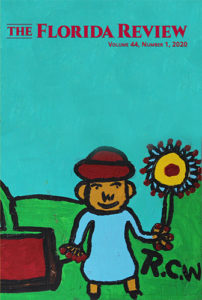The Florida Review – Winter 2009
Volume 34 Number 2
Winter 2009
Biannual
Karen Rigby
Photographed in sepia tones, a man holds a globe while facing the camera. John Bohannon’s cover plays with expectations of scale. It seems to evoke mastery, to suggest that man is large enough to contain the world in his hands, that the immense has suddenly become bearable. The latest volume of The Florida Review, however, often confirms that we are still very much of the world rather than standing somewhere beyond its concerns.
Photographed in sepia tones, a man holds a globe while facing the camera. John Bohannon’s cover plays with expectations of scale. It seems to evoke mastery, to suggest that man is large enough to contain the world in his hands, that the immense has suddenly become bearable. The latest volume of The Florida Review, however, often confirms that we are still very much of the world rather than standing somewhere beyond its concerns.
Grief, inexplicable cruelties, and a sober tone permeate many of these writings, from Deborah Thompson’s “Buying Time,” an essay on walking through a drugstore while facing her husband’s cancer, to Alyce Miller’s “Naming Dogs,” a portrayal of pitbulls rescued during a fighting raid. Poems containing violent imagery – such as “I imagined my neck breaking / upon impact” (E.C. Belli), “an open wrist / an accidental slip” (Susan Rich), “The drum and how it bled, the dream and how / It fed mothers on the auction block” (John Murillo), and the Colonel who “hanged himself” (Kerry James Evans) – continue the darker trend.
Baron Wormser writes an ekphrastic response to a photo of a sheriff, remarking that “Colored and white will leak / historic rage,” while Christine Gelineau explores the tense relationship Americans maintain with law enforcement: though they desire protection, they also bristle at the prospect of over-involvement. Even Fred Setterberg’s “Catechism,” a story that uses interfaith marriage as a humorous touchstone, names some of the notorious figures in the history of the Catholic church.
Though much seriousness is represented in this winter issue, lighter moments also appear. Jennifer duBois creates a narrator whose lie on a college application continues to plague him decades afterwards. The problem does not possess the same gravitas as death or the burden of social responsibility that appear in some of the essays, but still defines the character, and serves as another example of carrying a burden, a theme that recurs in other works. More notable items include an interview with Honor Moore, as well as work by the winners of the 2009 Editors’ Awards.
Readers that are new to The Florida Review would find it comfortably familiar. It follows a format common to many university journals, including an Editor’s Note at the beginning and a selection of book reviews and literary advertisements at the end. Printed on creamy paper, the perfect-bound issue is over 160 pages, using crisp typography with graceful adornments in the form of a bird logo. It is not one of the more visually-oriented journals with adventurous, dynamic design elements. Nor is it meant to be. Content is king, as the expression goes, and here, it is most noticeable in the essays, all of which are on par with non-fiction found in venues such as The Missouri Review, and all of which bite in sometimes haunting, sometimes damning ways.
[floridareview.cah.ucf.edu/]


